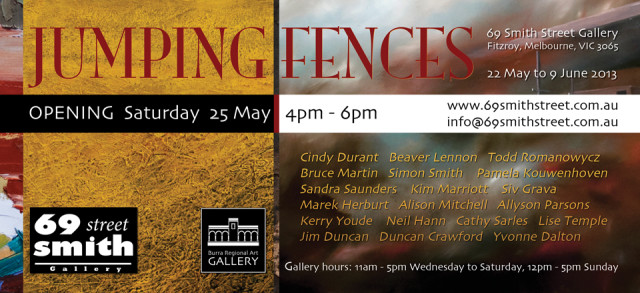Jumping Fences – Burra Regional Art Gallery to 69 Smith Street Gallery 2013
JUMPING FENCES: Burra Regional Art Gallery 28 February to 1 May 2013
and 69 Smith Street Gallery, Fitzroy, Melbourne 22 May to 9 June.
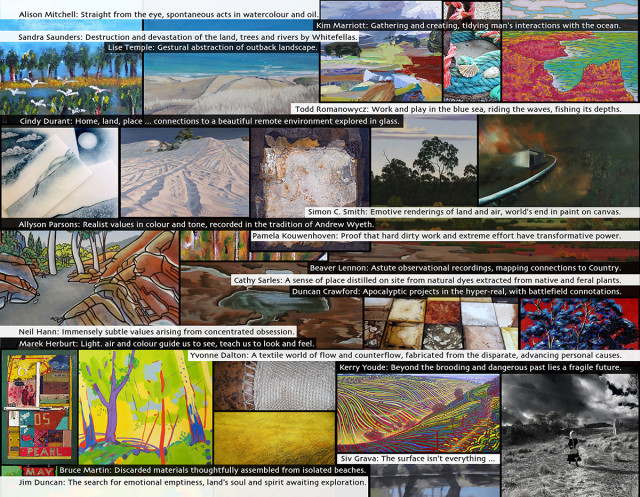
Jumping Fences is an exhibition of landscape work based on an idea I had last year when I realised how well positioned Burra Gallery is to bring regional artists together and take them further in desired directions. I see a lot of creative activity choked up in its own region, much of it virtually unknown outside. From 69 Smith Street’s view, this will be work “from the other side”.
The exhibition is showing in Burra Gallery to the end of April 2013 before making the trip to 69 Smith Street Gallery (May 22 to June 9) for the final important stage of fence jumping.
Burra Gallery is undertaking this approach to boost artists over some of the hurdles of living in country SA, presenting a united front to a new audience and supporting each other along the way, with assistance from both galleries.
The “fences” are Spencer Gulf, which separates South Australia’s settled areas from each other, the SA/Vic border, distance and a line on the map isolate us, and the mindset of these divides. This exhibition is an attempt to answer these challenges and celebrate the unique qualities of the work.
I have chosen a mix of experienced and emerging artists. This helps to surmount another barrier for the latter in the development of their skills, especially living in regions far from the city. Our busy Arts Officers look out for these artists and are very enthusiastic about the opportunities this exhibition offers. I have also chosen a mix of both Indigenous and non-Indigenous artists.
John Neylon’s words bring attention to the artists and their works as a serious foray onto new ground. The essay enhances and clarifies the concept of clearing barriers that the exhibition promotes and places artists’ work in context with the landscape they inhabit and love.
John has recently curated an exhibition Tough(er) Love: Art from Eyre Peninsula on display until 28 April 2013 in the Flinders University City Gallery, showing the work of some of the West Coast artists included in “Jumping Fences”.
Lis Jones Ingman, Curator
March 2013
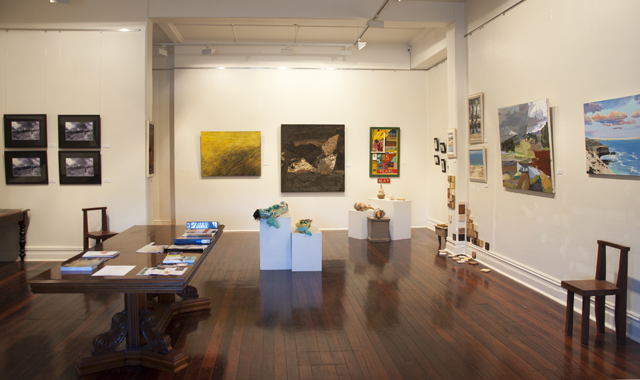
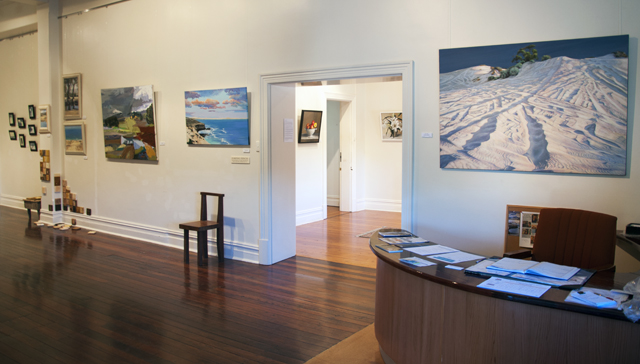
INTRODUCING THE ARTISTS with short reviews by ‘Artivist’
South Australia’s West Coast artists
Cindy Durant – glass artist from Penong, with a landscape bent
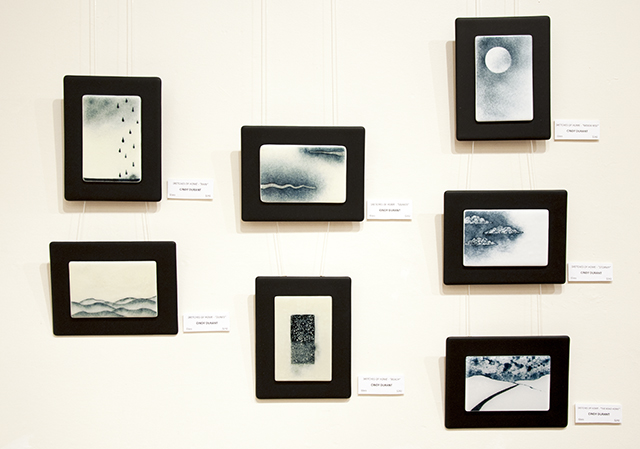
Cindy Durant – Sketches of Home – Glass – $242 each
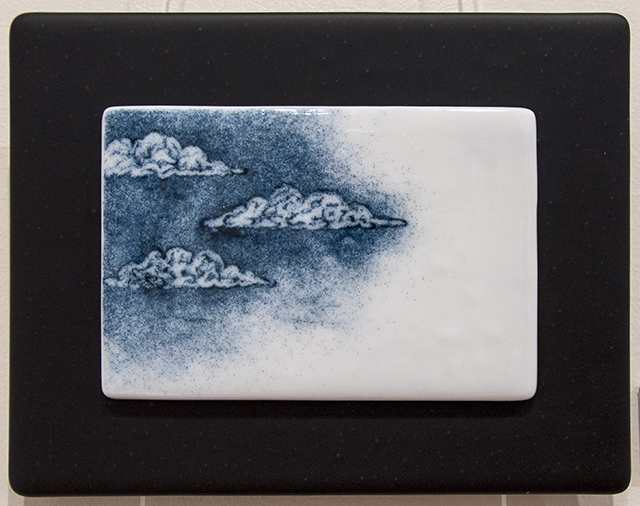
Cindy Durant – Sketches of Home – Stormy – Glass – $242
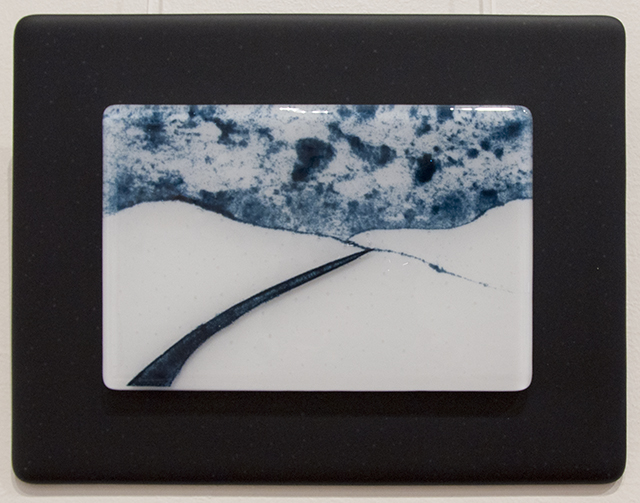
Cindy Durant – Sketches of Home – The Road Home – Glass – $242
Pared back lonely pieces, but together! What a statement they make about “home” – a place of little rain, dunes, isolated beaches, distance and hot dry air.
Beaver Lennon – from Ceduna, painting Country with beauty and dignity
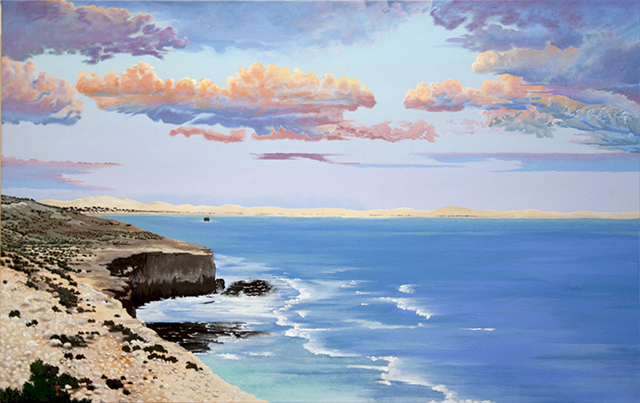
Beaver Lennon – Beginning of the Bunda Cliff – Acrylic on Canvas – $2240
The long glorious coastline of Head of Bight celebrated here in no uncertain terms, Beaver’s country. And this is our land too! It exists! It’s true!
Pamela Kouwenhoven – installation artist, and sculptor in abandoned materials
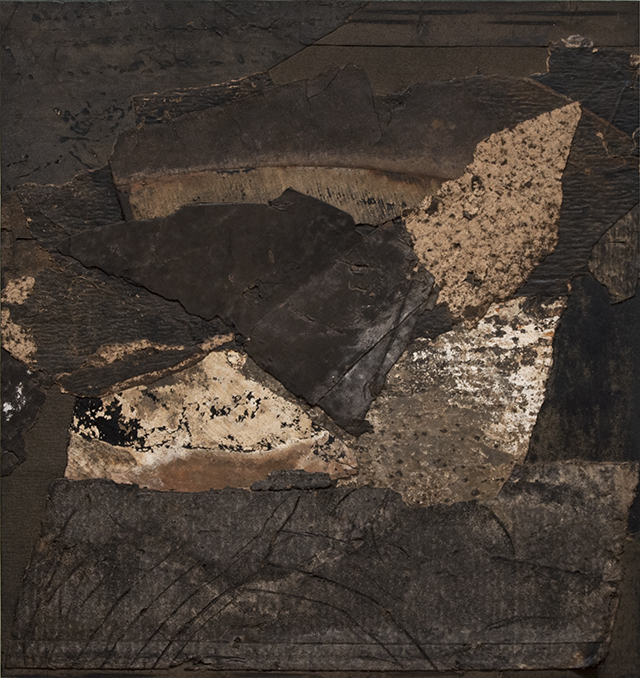
Pamela Kouwenhoven – Pressing Dryland – Site 3 – Discarded Malthoid on Board – $7000
A work in bitumen, made from recycled malthoid rescued from the bottom of old water tanks, tells us of heat and pressure, and the dryness of our overworked earth.
Bruce Martin – assemblage using found timber, objects, and paint
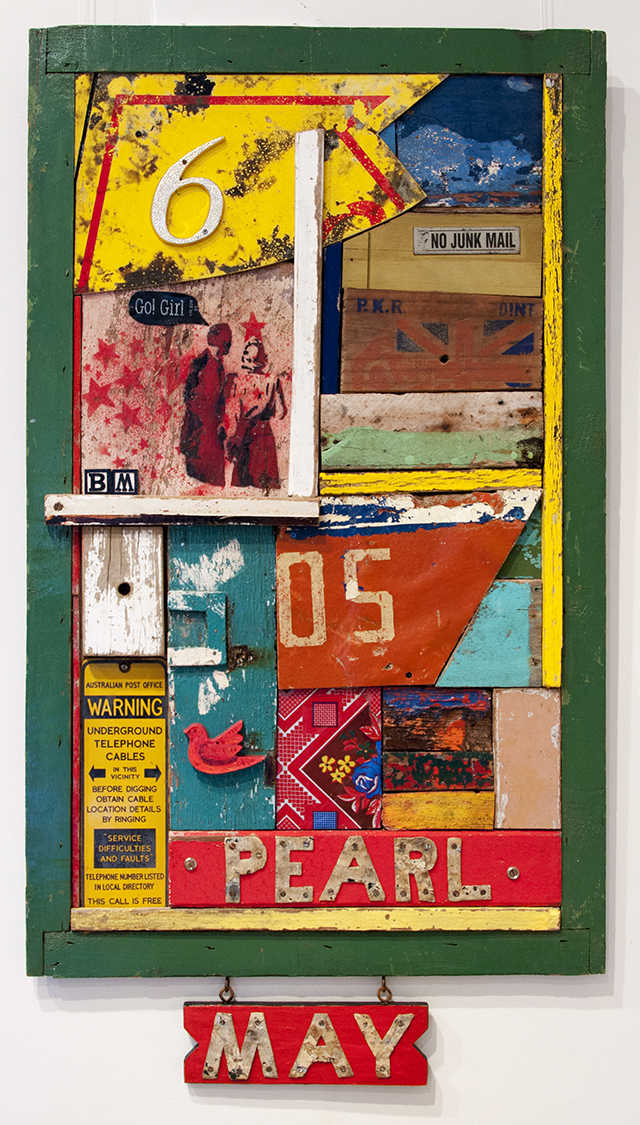
Bruce Martin – Pearl May – Driftwood – $750
Amazing what you can find on the beach and the stories they tell when put together by the hands of an artist/poet – language puzzling in its eloquence.
Simon Smith – an emerging painter of visual distinction, just completed BAVA
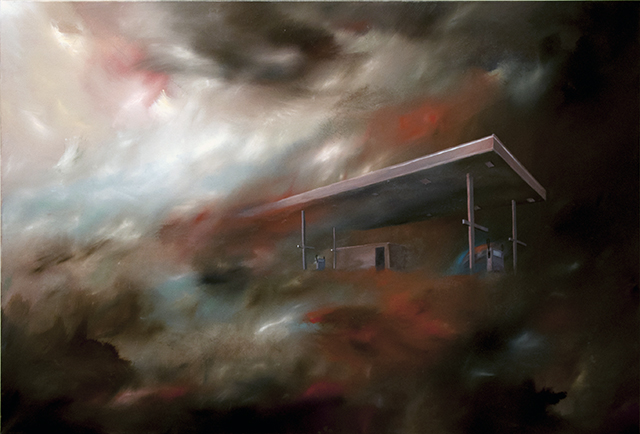
Simon C Smith – Lost Highway – Oil on Canvas – $1500
Space and time a looming presence in “Lost Highway” – the dystopian road to nowhere, stopping off at a petrol station to fill up and be on our way. Who knows where?
Todd Romanowycz – painter and partaker of surf scene, moving steadily forward
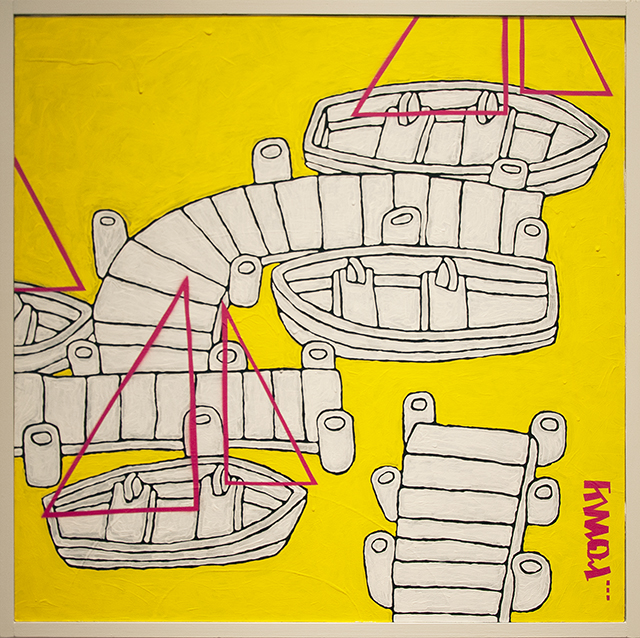
Todd Romanowycz – Boat Harbour at sunset – Mixed Media on board – $500
Paint on the edge of control, colour hemmed by line, held in place by wharf and boats – a new experiment to manage the sea and bit by bit contain it.
Sandra Saunders – painter, often of found surfaces, always political
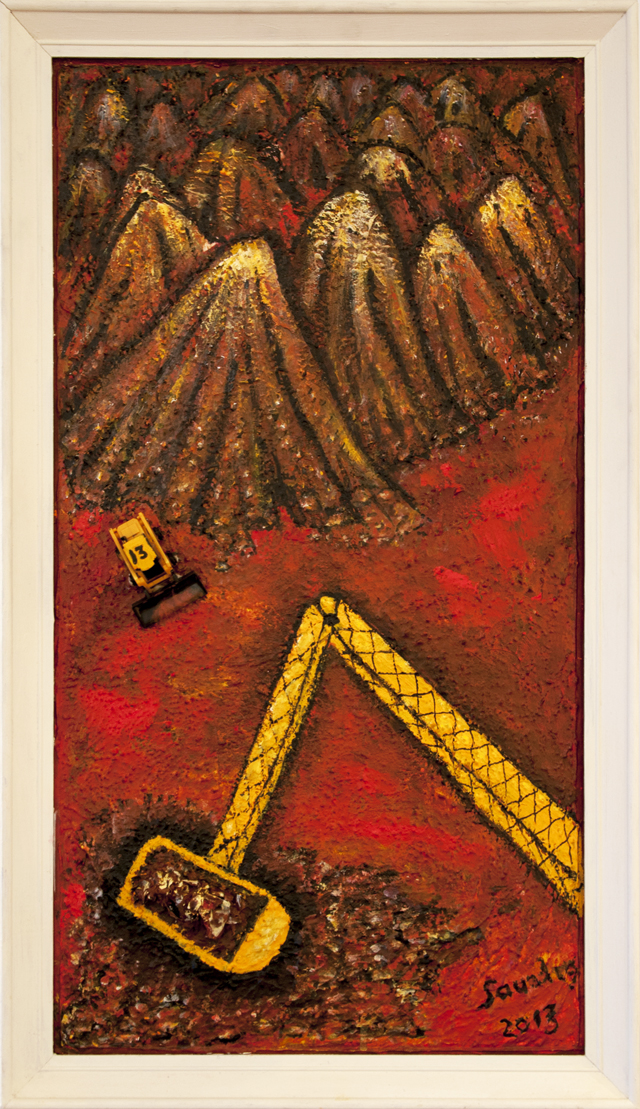
Sandra Saunders Rape of Mother Earth acrylic on board
Scraping, digging, making holes and filling them in again – that’s what we do for the sake of progress. That’s what we do to make things better! Where’s my money? We should be ashamed!
Kim Marriott – basketry from the beach, inspired by coastal landscape
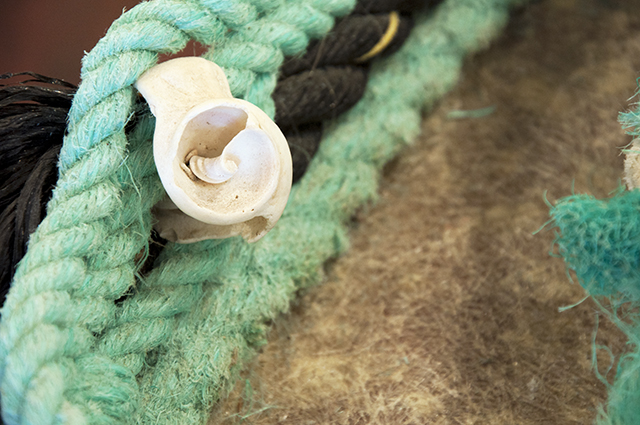
Kim Marriott – detail
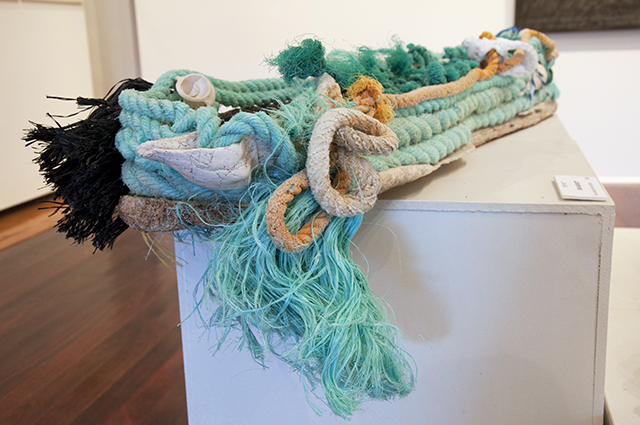
Kim Marriott
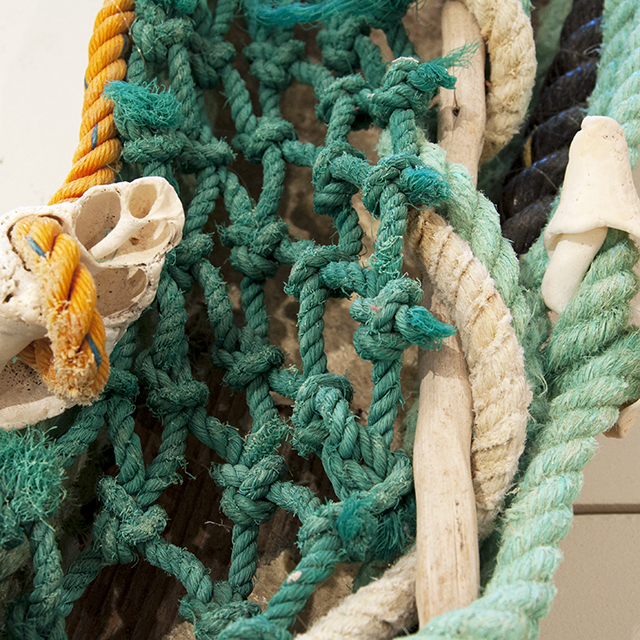
Kim Marriott – detail
Baskets of flotsam drift by, the bleached colours of sea and sand, we are tying the ocean up in knots with our cast offs. Shells and bits of old mangrove add harmony to the mix.
Siv Grava – fascinated by the intangible
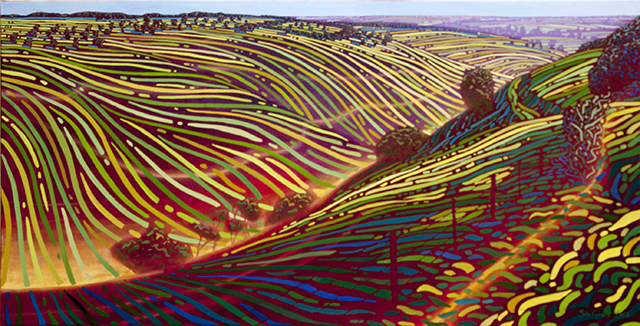
Siv Grava
Deep magenta purple and then some, painted lines in yellow, green and blue describe the forms of vastness. Far into the distance our eyes glide – a journey to the edge of perception.
On the Burra side of Spencer Gulf
Neil Hann – works founded on research, with complex layering of ideas
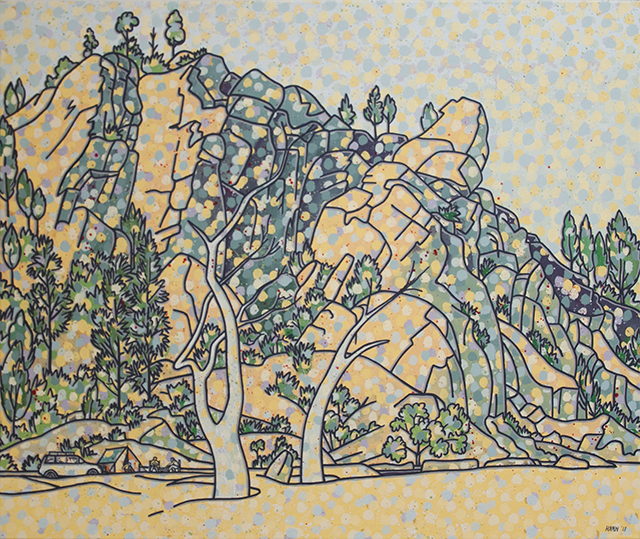
Neil Hann – Camping at Mudlapena Gap – Acrylic on Canvas – $1600
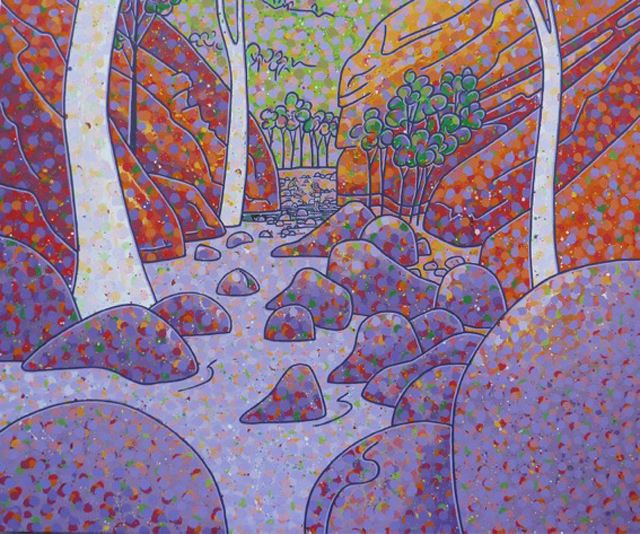
Neil Hann – Wading Through Edeowie Gap – Acrylic on Canvas – $1600
Lines placed just so, and the view is at our fingertips, colours placed seemingly casually cause trees and boulders to move forward and back in the space. This artist plays with chaos.
Marek Herburt – semi-abstract colourist, from Europe to the Australian bush
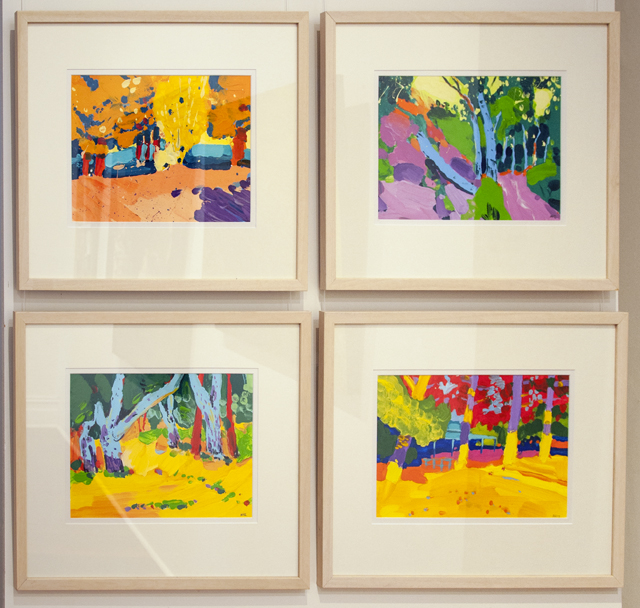
Marek Herburt
Clean bright colours zing madly against each other, paint on brush clamouring faster, grabbing the airy moment. Four works by a master.
Alison Mitchell – spontaneous seen images, recorded with insight and skill
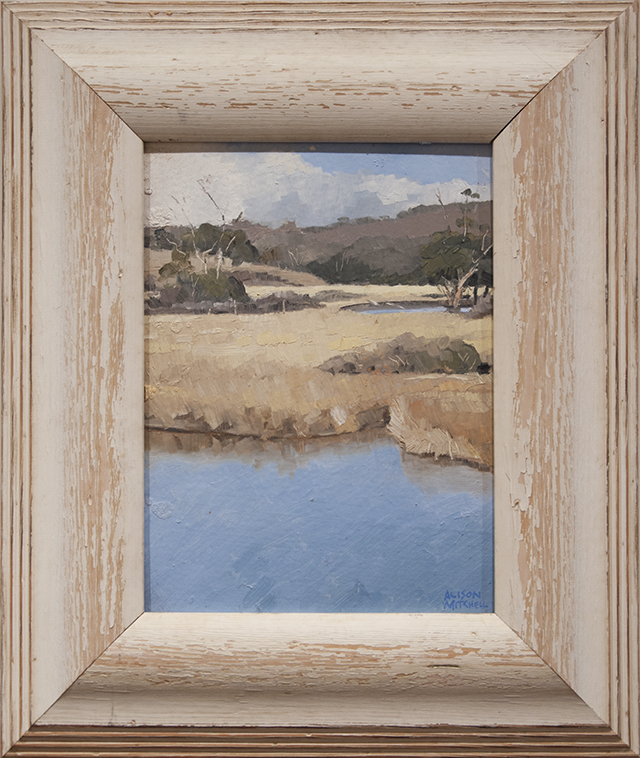
Alison Mitchell – Middle River, Kangaroo Island – Oil on Canvas – $1500
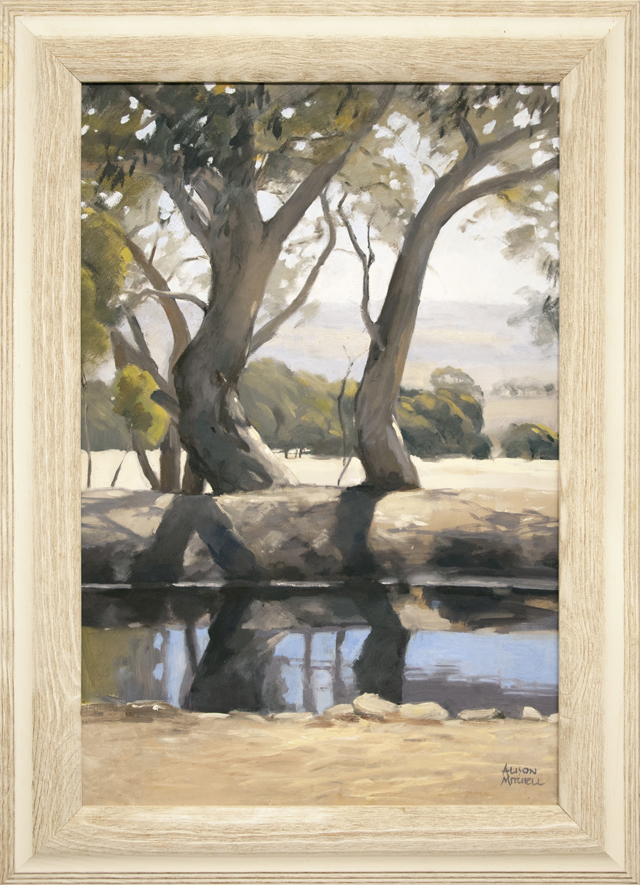
Alison Mitchell – Last Water in Dam – Riverton – oil on board
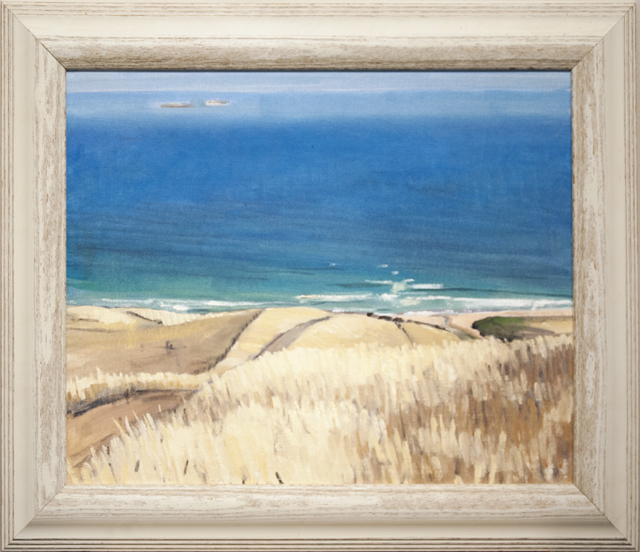
Alison Mitchell – View from Tungkalillo
These are three beautifully seen works in oil paint. The artist’s eye draws us to water – the river, the dam and the wide blue empty ocean – calm and waiting.
Allyson Parsons – painter of bygone times, as found today, all round the country
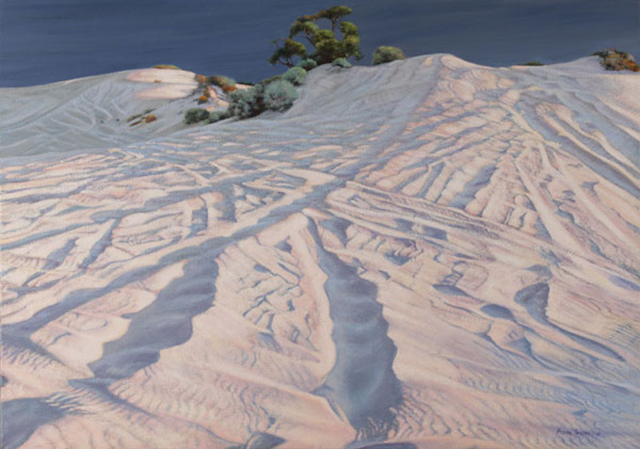
Allyson Parsons – Wild Sands – Acrylic
Cool sand of dunes at night, moved around and pushed aside by four-wheel drives, a patch of scrub almost overwhelmed but still struggling to hold everything together.
Cathy Sarles – dyeing of canvas using bush ingredients
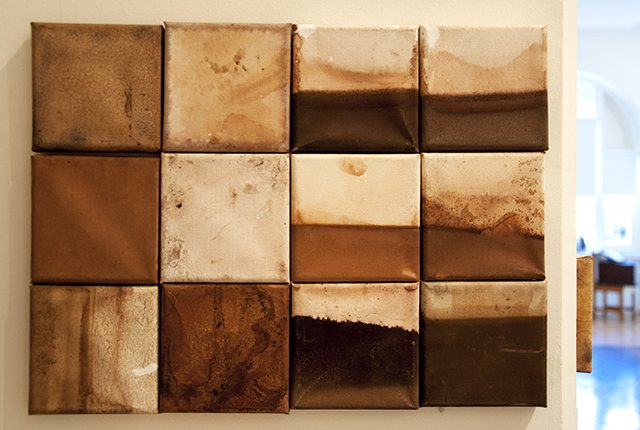
Cathy Sarles – Leaf Litter – Plant dyes on Canvas – $18 each – detail
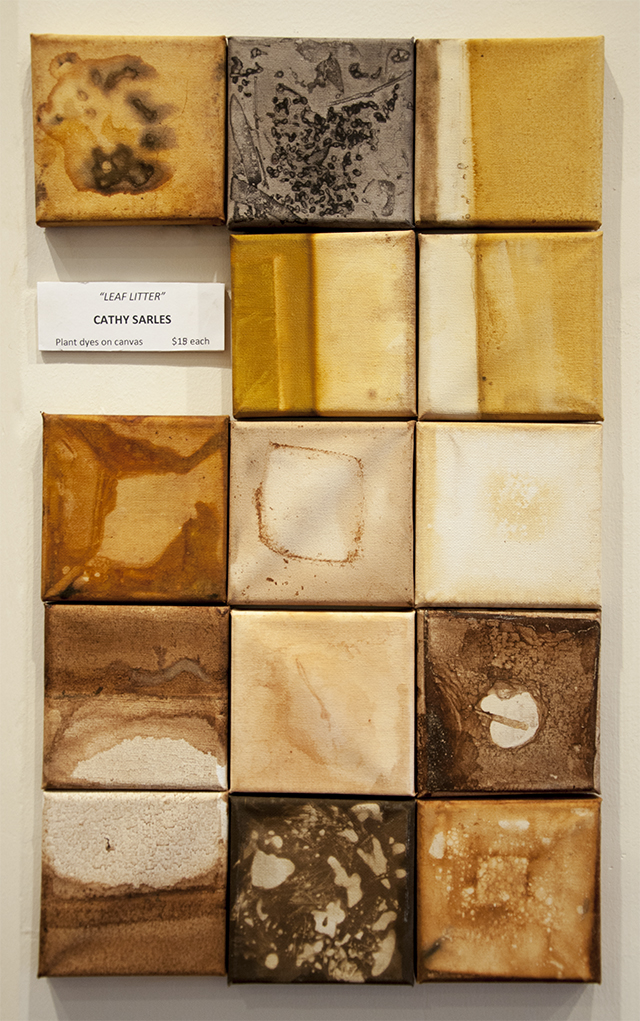
Cathy Sarles – Leaf Litter – Plant dyes on Canvas – $18 each – detail
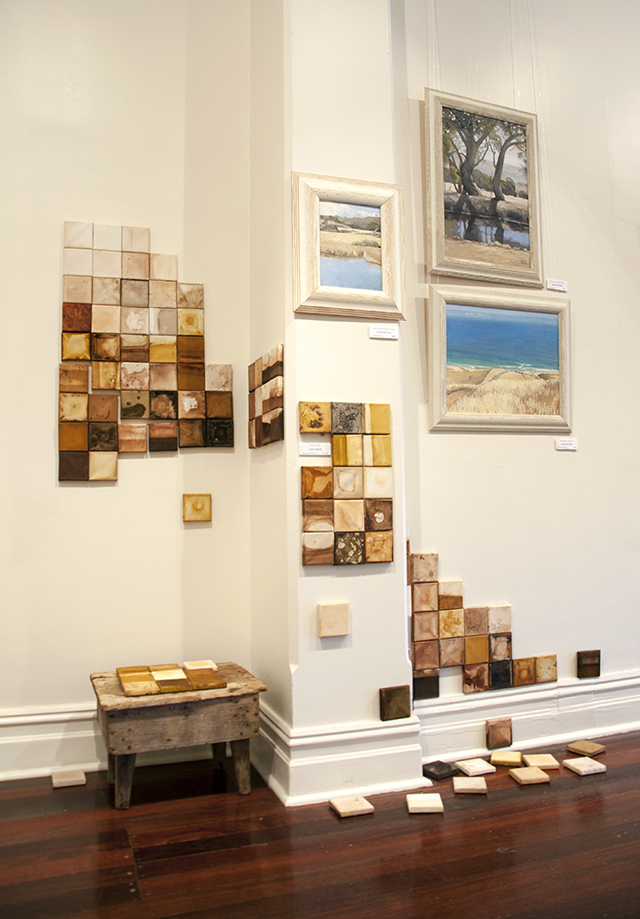
Cathy Sarles – Leaf Litter – Plant dyes on Canvas – $18 each
Individual tiny canvases, stained by essences of plants from the Flinders Ranges, randomly arranged like pebbles in a creek bed or leaves scattered on the ground, each precise and lovingly made.
Kerry Youde – photography and computer aided imagery in romantic style
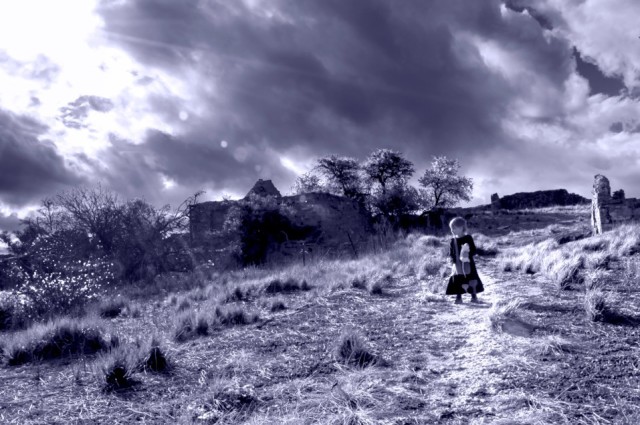
Kerry Youde – Time Traveller 1 – Digital Photograph on Art Paper – $300
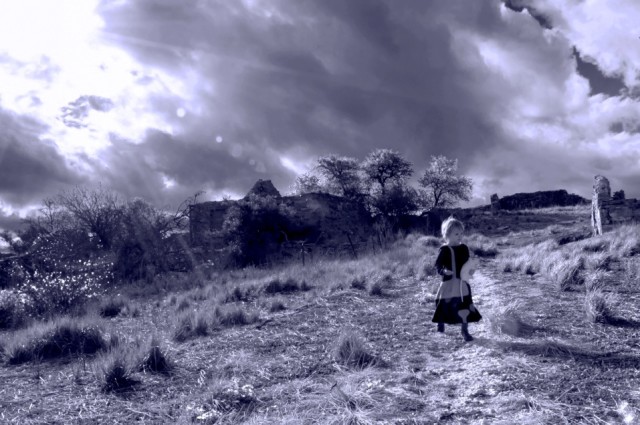
Kerry Youde – Time Traveller 4 – Digital Photograph on Art Paper – $300
A step at a time moves a child into the present with composed confidence. Four clicks, four moments give us a glimpse of hopes for the future for one small person taking it on for us all.
Yvonne Dalton – textiles related to landscape worked as sculptural objects
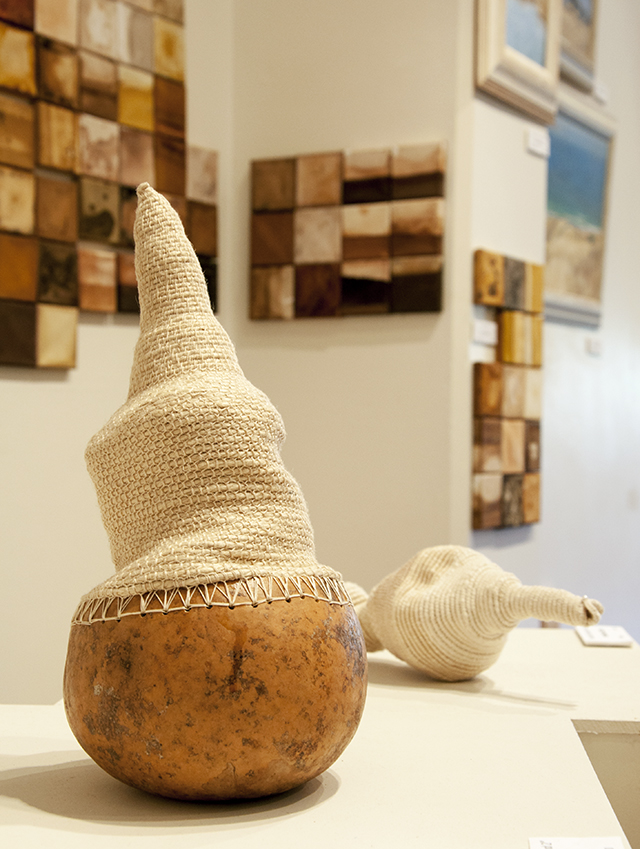
Yvonne Dalton – Landscape Memory – Textile – $450
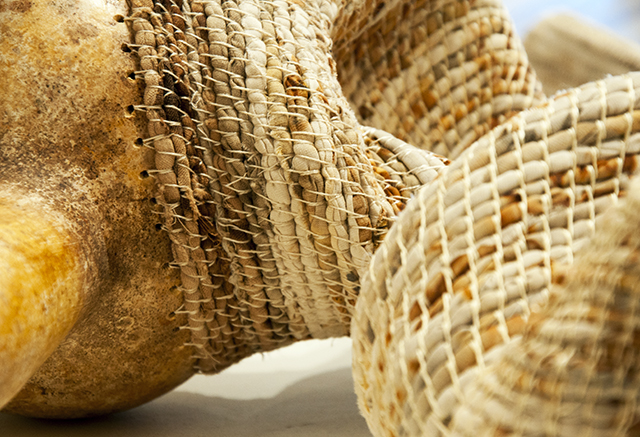
Yvonne Dalton – Landscape Memory – Textile – $450 – detail
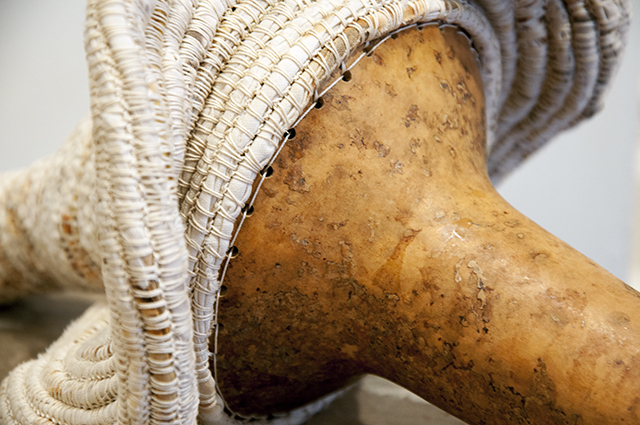
Yvonne Dalton – Landscape Memory – Pod 3 – Textile – $450 – detail
Objects of mysterious provenance with links to utensils remind us of the effort of fabricating, the skill needed to make something by hand. And the satisfaction so gained.
Jim Duncan – explores the emotions aroused by marginal country
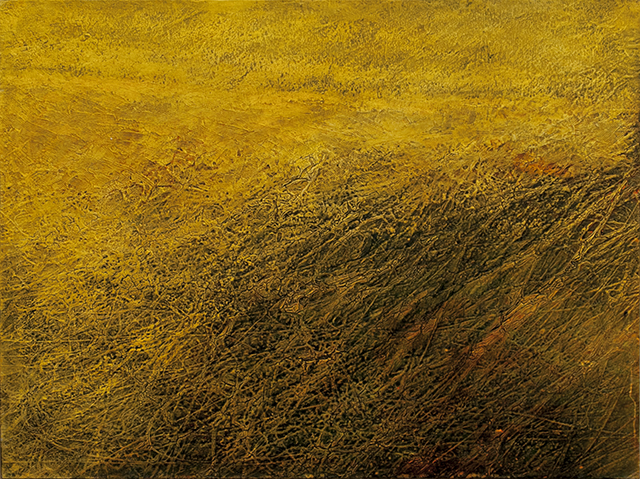
Jim Duncan – Four Bushels an Acre – Acrylic – $3000
Wind blows the ripe wheat, harvest time ahead. This exhibit is part of Jim’s Goyder’s Line series of works, shown late 2012 in Hahndorf Academy.
Duncan Crawford – a farmer’s view of the land, both seen and imagined
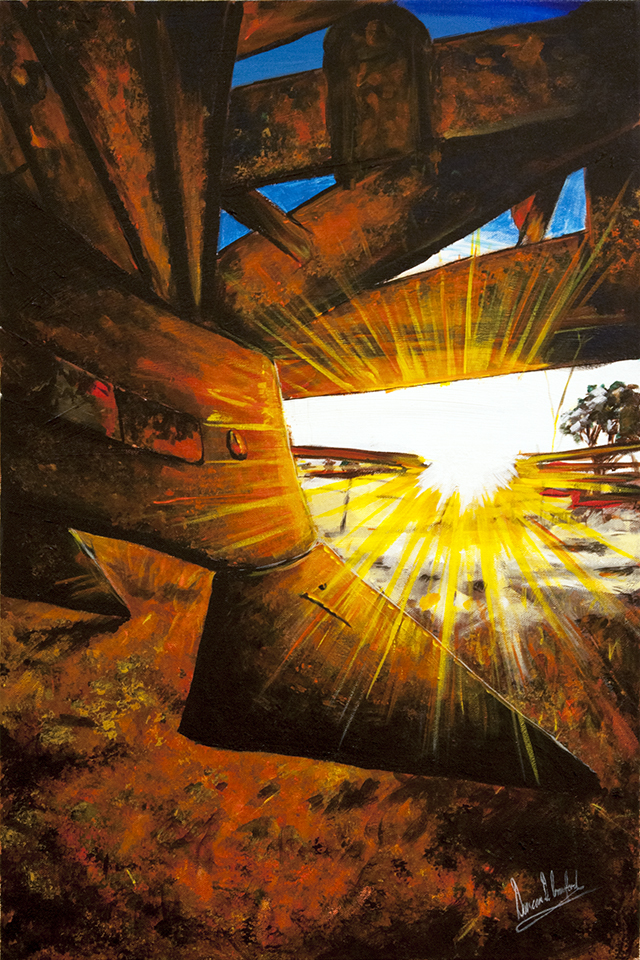
Duncan Crawford – Plough Rays – Acrylic on Canvas
A sun sets between the blades of an old plough. Earth turns with a grinding clank of gears, rust and stones mingle in the dusty soil, making a place to grow next year’s crop.
Lise Temple – overlay of landscape imagery carried out in broad-brush abstract
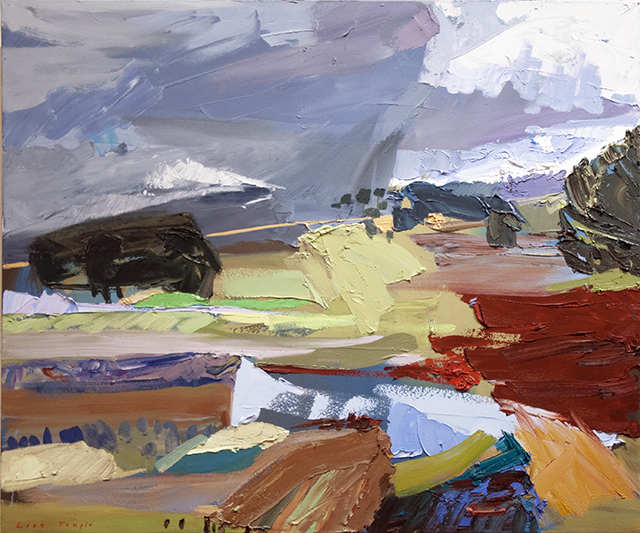
Lise Temple – Winters Journey V – Oil – $2900
Blobs and daubs and swathes of luscious colour, the Mid North landscape under cloudburst, a short sharp shower blocks the light, but not for long.
Lis Jones Ingman, Curator
March 2013
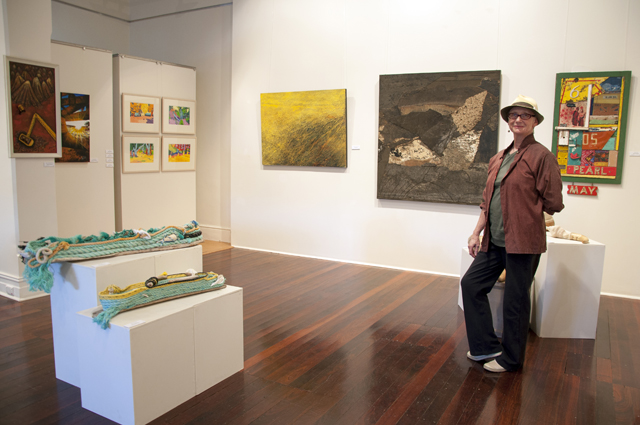
Lis Jones Ingman – Curator
Jumping fences is a tricky business. Misjudge the run up. Trail a foot or fetlock and disaster strikes. It happens on farms. It can happen in the art game. The term is synonymous with opportunism and breaking down barriers. For the curator of Jumping Fences, Lis Jones Ingman, it’s all about pushing the boundaries and opening up opportunities. Too often she has observed creative activity around the old copper mining township of Burra and the Mid North of South Australia ‘choked up in its own region’, virtually unknown elsewhere. Jumping Fences is a break out strategy, a test case for a regional gallery to explore the potential of brokering cross-regional marketing and collaborative ventures for geographically dispersed but regionally clustered artists. It also comprises a mix of artists from opposite sides of a notional fence which on a clear day looks like the stretch of water called Spencer Gulf, separating that strip of mainly pastoral land which runs through South Australia’s Mid to Lower North and something quite different called Eyre Peninsula. Virtually an island, the “West Coast” has vast hinterlands and remote rugged coastlines. Remote, maybe, or on the old fringes of nineteenth century pastoral settlement, but the seedbed of a new generation of artists who embrace the challenge and opportunities offered by living not so much away from perceived centres of culture but within extraordinary cultural, historical and natural environments. Many Australians may only come to know about places like this through the power of art.
Consider the creative life experiences of artists living on the Far West Coast of Eyre Peninsula. Cindy Durant, a glass artist, lives in one of the most compelling of environments, on the coast, near Cactus Beach. Her art is a reflection of the bare-boned beauty of this almost surreal place. The blinding light of salt-encrusted lakes, the shimmer of snake skin in the sun and sand ripples of receding tides are embodied in the sculptural forms which Durant crafts within her studio. Beaver Lennon, who traces his ancestry in part to the whale-dreaming Mirning people of the Head of the Bight way out towards the Western Australian border, paints with the clear vision of someone seeing the landscape as if for the first time, in terms of its visual complexity and his cultural identity. Inland from the coast, memories of a childhood spent on marginal land cleared by her grandfather in the 1920s, inform the Bible-black malthoid panels of Pamela Kouwenhoven which speak of limestone, aridity and tenacity in the blood. On the other side of the Gulf a number of artists engage with a different kind of landscape, one measured by advance and retreat as early settlers probed the possibilities of the land, making a living in the more fertile places or beaten into submission by drought – and the rabbits. One of the artists, Jim Duncan, is tracing through his work, one of Australia’s most famous ‘fences’, Goyder’s Line named after George Goyder who in 1865 published his Line of Rainfall, which effectively declared the limits of outer settlement. There were lots of fence-jumping farmers at the time keen to disprove Goyder and his ‘line of foolery’. The price of their folly is measured today in long-abandoned farms and stony paddocks. Ruined but not completely abandoned. Artists like Allyson Parsons have a poetic way with old ruined things and dusty paddocks at the end of the season. Call her a ‘shed whisperer’.
The way north from Adelaide starts as a colonial journey of dreams of an inland sea and the wealth provided by agriculture (as evoked in Lise Temple’s abstracted wheat fields and vineyards), now ominously close to the advancing city, and of the bounty delivered by fat merino sheep and Cornish miners toiling for copper in Kapunda and Burra. Then the dream fades. First it’s rain shadow country, then over the fence into the Flinders where the weight of tens of thousands of years of Aboriginal lived experience and of deep geological time presses down on a mere two hundred years of pastoral settlement and mining endeavour. In this context the artist Neil Hann is less a fence jumper, more a boundary rider. Fences here tend to lie down and die – or get eaten by goats. That leaves the land, or should that be the stumps of once-were mighty mountains, Rocky Mountain high, now translated in Hann’s Flinders-inspired paintings into linear graphs of natural forces at play. The expression ’jumping fences’ in the context of this exhibition reveals much about the outlook of the artists and indeed the organising agency of the Burra Regional Gallery. Because so many artists in regional South Australia work in relatively remote areas, while at the same time keeping informed about and positioning their work within the wider world, there is a culture of both self-reliance and interdependence which shines through the intent and delivery of the Jumping Fences project. South Australia, and indeed artists on both sides of Spencer Gulf, are not unique in this regard as the Murray Darling Palimpsest project, for example, continues to demonstrate. Make no mistake, regional arts in Australia is muscling up and, by way of example, these cross-gulf artists in jumping the big fence of the Mallee while keeping a wary eye on Goyder’s Line, and heading down the Western Highway, through Bacchus Marsh and Flemington and finally to 69 Smith Street Fitzroy, Melbourne, is really coming to town.
John Neylon December 2012
John Neylon is an Adelaide-based independent curator and art writer.
He is curator of tough(er) love: art from Eyre Peninsula, Flinders University City Gallery, 23 February – 28 April 2013
